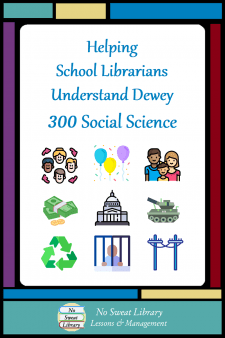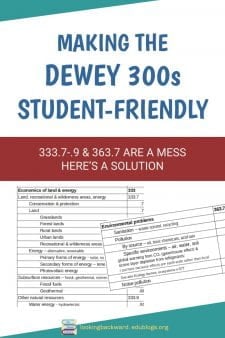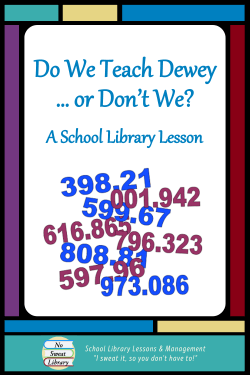 I don’t teach the Dewey Decimal Classification System during Library Orientation. In fact, I don’t teach it at all!
I don’t teach the Dewey Decimal Classification System during Library Orientation. In fact, I don’t teach it at all!
The eye-opener came my second year as a librarian when I was telling students (during an incredibly boring orientation) that library books were originally shelved behind the circulation desk, and the DDC was created so librarians could organize books to find one when a patron asked for it. I suddenly realized that the DDC is for me to know for organizing books, not for students to know for finding one.
Students only need to know how to find a number on a shelf, and anyone who can put 3 or 4 numbers in consecutive order can do that—even a kindergartner!
CAN I JUSTIFY NOT TEACHING DEWEY?
Few School Librarians understand “Classes” and “Divisions” of DDC, or what it means that DDC organizes those Classes & Divisions by discipline. While the 10 Classes are pretty easy to remember, most School Librarians know only a few Dewey Divisions. Quick: name the 10 Divisions of the 700s Arts & Leisure. And that’s an easy one! If we School Librarians don’t even know the DDCS, why should a kid?
Secondly, the AASL National School Library Standards never mention the Dewey Decimal Classification System. (Nor did the Standards for a 21st Century Learner!) It’s not even listed in the Glossary or the Index. It’s only at the School Library level that there’s a hint at a classification system:
IV. CURATE C. SHARE 2. The school library facilitates the contribution and exchange within and among learning communities by including and tracking collection materials in a system that uses standardized approaches to description & location. (p.62)
As for School Librarians, there’s not even a hint at a classification system; this is as close as they get:
IV. CURATE A. THINK 2. School librarians challenge learners to act on an information need by designing opportunities for learners to explore possible information sources. (p. 50)
I particularly like the wording “opportunities for learners to explore,” and I’ve written about such opportunities for Science and for Social Studies that coordinates both the discipline of Dewey and classroom learning.
So, if our own Standards don’t specify the DDCS for us or for learners, we don’t need to teach Dewey!
Finally, the trend in education is away from content-based instruction and toward developing critical-thinking through inquiry and problem-solving. The school library is all about inquiry and problem-solving, so why would we continue to teach a content-based lesson on the Dewey Decimal Classification System?
WHAT TO TEACH INSTEAD OF DEWEY
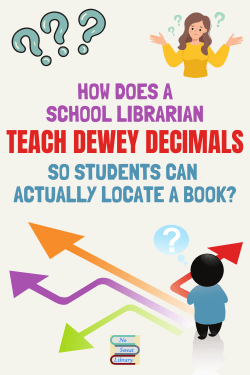 As School Librarians, our main concern is about helping students learn how to use an organization system to locate resources. Thus, we teach students about our online catalog, and that, after using it to identify whether the school library has a book, they only need a number to find the book on the shelf.
As School Librarians, our main concern is about helping students learn how to use an organization system to locate resources. Thus, we teach students about our online catalog, and that, after using it to identify whether the school library has a book, they only need a number to find the book on the shelf.
This goes beyond just a lesson; it touches on the latest trend of dumping Dewey for a “kid-friendly” word-based system. I’m astonished when I hear this, since Dewey is itself a short, simple notation for locating a book on the shelf. I doubt that kids are any more likely to “learn” letter acronyms than Dewey numbers.
They’ll still have to search By Subject, we’ll still have to teach them how to use the system to find a book, and we’ll still need to put signs on the shelves, all of which we can do just as easily with Dewey numbers!
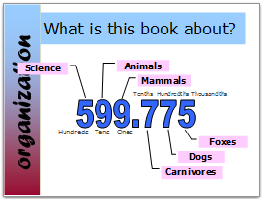
A slide about place value from my math lessons.
Students do need to understand that each place value in a Dewey decimal number stands for a more specific subject or topic, so more decimals mean a narrower topic of a book. What those subjects or topics are should be a sign on a shelf, not a scrap of trivia in a kid’s brain.
Granted, for elementary students, especially very young ones who haven’t learned about decimals, Dewey numbers may seem a bit daunting, but even a kindergartner quickly learns to count to 100, and helping kids discern and practice numerical order is a more important skill to focus on than what the numbers stand for.
It’s incredible that many of my middle schoolers can’t do this, so a lesson activity that sends kids off to find books by number is not only a better strategy for the library—and for reinforcing Math skills—but it’s a lot more fun! At least it always is for my students since I changed my lessons from content to process!
DO DEWEY WITH MATH CLASSES!
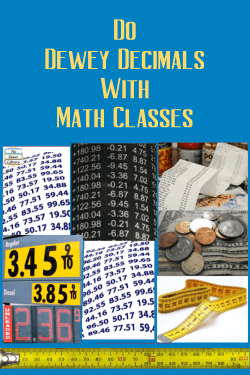 I suggest that our reluctance to focus on number location is due to math anxiety—after all, most librarians seem to come from a language arts background, not a math one. But think about it: Numbers and decimals are part of the math curriculum, so why not bring in math classes for a Dewey lesson? They rarely use the library, so a Dewey Decimal lesson gives Math classes a curricular reason to visit the school library, especially when we offer a practical, hands-on application of decimal concepts. And it certainly answers the common question in math about “When are we ever going to use this?”
I suggest that our reluctance to focus on number location is due to math anxiety—after all, most librarians seem to come from a language arts background, not a math one. But think about it: Numbers and decimals are part of the math curriculum, so why not bring in math classes for a Dewey lesson? They rarely use the library, so a Dewey Decimal lesson gives Math classes a curricular reason to visit the school library, especially when we offer a practical, hands-on application of decimal concepts. And it certainly answers the common question in math about “When are we ever going to use this?”
Thanks to a suggestion from my library colleague, Cindy Nietubicz, I bring both 6th and 7th grade Math classes into the library for a Dewey Decimal Lesson. The timing is perfect for us—these math classes begin decimal units about 5 weeks into the school year, when our ELA fiction reading pattern is well established and students are eager to check out Dewey books.
My math lessons serve to activate prior math knowledge about what students should already know about decimals, so it prepares them for their upcoming unit. With 6g students we review place values and sequencing decimals; with 7g students we review adding and subtracting decimals. Students practice how decimals are used in the library by locating Dewey-decimal-number books on the shelf. Math teachers like having this fun, non-graded review where they can see which students are having trouble with decimals.
 Animated lesson slide for students to practice putting decimals in order. Animated lesson slide for students to practice putting decimals in order. |
After the practice activity, students have plenty of time to browse for Dewey books to check out. Many get an interesting book they find during the activity. Others are stimulated to use my signage to find Dewey numbers of their favorite topics. When students are seated, we follow the same silent reading and invited checkout procedure that we use for ELA classes.
Math teachers love these lessons so much that they come to me early in the school year to see when we can schedule them into the library. It also whets their interest in collaborating on other math-related lessons in the library. Students love these lessons, too. Sixth graders are always puzzled about why they’re in the library with a math class…most have never done that before. What amazes me is how many comment afterward that now they understand how all those numbers work, which is, of course, the whole point of teaching Dewey numbers to our students.
WHY DO I SAY “DEWEY NUMBERS”?
You may be wondering why I deliberately use the phrase Dewey numbers—and Dewey books. I identify areas of the library by what’s on the spine labels of the books; since there’s a Dewey number on the spine labels, it’s the Dewey area of the library.
My decision to begin doing this came during the aforementioned (incredibly boring) orientation: I was explaining that we separate fiction books from the 800s into their own area of the library, but the ‘non-fiction’ area still had some fictional books, such as aliens and fairy tales. I thought, “Why am I making this so confusing to students? If I just call them Dewey-number books I’ll alleviate confusion and questions!” So from then on, that’s what I called them.
Now I clarify with students that ‘non-fiction’ is about the content of a book, not it’s location. If you take anything from this blog post, I hope it’s the terms ‘Dewey area’ and ‘Dewey-number books’ instead of ‘nonfiction.’ Our kids deserve common sense.
![]()
If the slide images above have sparked your interest, you can find my Dewey Lessons in my No Sweat Library store on TeachersPayTeachers, as well as my colorful Dewey Subject Signs & Shelf Labels.
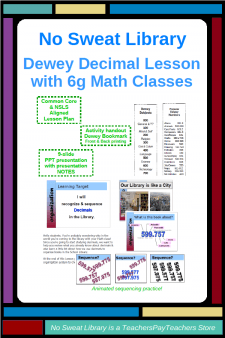 |
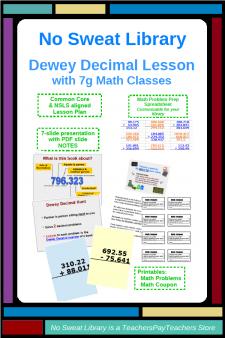 |
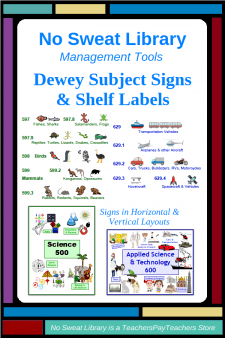 |


